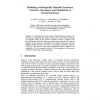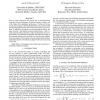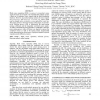35 search results - page 3 / 7 » Blind signal processing by the adaptive activation function ... |
ESANN
2004
13 years 7 months ago
2004
To emphasize the electrical nature of information processing in the brain we use a compartmental model of single neurons. The realistic simulation of wave-like activity in the recu...
ICASSP
2008
IEEE
14 years 18 days ago
2008
IEEE
From an audio perspective, the present state of teleconferencing technology leaves something to be desired; speaker overlap is one of the causes of this inadequate performance. To...
ICASSP
2011
IEEE
12 years 9 months ago
2011
IEEE
Functional magnetic resonance imaging (fMRI) is a popular tool for studying brain activity due to its non-invasiveness. Conventionally an expected response needs to be available f...
HVEI
2010
13 years 7 months ago
2010
The use of functional magnetic resonance imaging (fMRI) to measure functional connectivity among brain areas has the potential to identify neural networks associated with particul...
ICASSP
2011
IEEE
12 years 9 months ago
2011
IEEE
Blind source separation (BSS) is a process to reconstruct source signals from the mixed signals. The standard BSS methods assume a fixed set of stationary source signals with the ...



